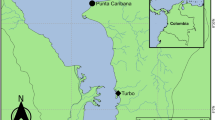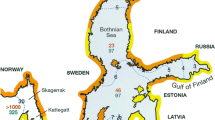Summary
The Gulf of St. Lawrence and the Baltic Sea receive comparable quantities of freshwater annually but the inflow to the Baltic brings twice as much organic matter. Annual productionin situ is similar in the two systems (38 to 53 million tonnes per year as organic carbon) but less than 10% of the organic matter produced in, and brought by freshwater to, the Baltic leaves that system, whereas the export of organic matter from the Gulf is over 25%. Consequences are greater depletion of oxygen in the deeper waters, and accumulation of organic matter in the sediments, of the Baltic Sea, as compared to the Gulf of St. Lawrence.
Zusammenfassung
Der Golf von St. Lawrence und die Ostsee gleichen sich hinsichtlich ihrer Süßwasserzuflüsse, aber die Süßwasserzuflüsse in die Ostsee bringen doppelt so viel organische Stoffe. Die Primärproduktion ist in beiden Gebieten mit 38 bis 53 Millionen Tonnen organischen Kohlenstoffs pro Jahr etwa gleich. Die Ostsee gibt von den zugeführten und durch Primärproduktion erzeugten organischen Stoffen etwa 9%, der Golf etwa 26% an die Nachbargewässer ab. Die Folge dieser Unterschiedlichkeit ist eine höhere Sauerstoffzehrung im Tiefenwasser sowie eine größere Anreicherung organischen Materials im Sediment der Ostsee.
Résumé
Le Golfe du Saint-Laurent et la Mer Baltique reçoivent chaque année des quantités d'eau douce comparables, mais l'intrusion d'eau douce dans la Mer Baltique y amène deux fois de plus de matière organique. La production primaire annuellein situ est identique dans les deux systèmes (38 à 53 millions de tonnes de carbone organique par an) mais il ne s'échappe de la Mer Baltique qu'environ 9% de la matière organique qui y est produite ou qui y est amenée par l'eau douce, tandis que la perte de matière organique dans le Golfe du Saint-Laurent est aux alentours de 26%. La conséquence pour la Mer Baltique, comparée au Golfe du Saint-Laurent, est un plus grand épuisement de l'oxygène dans les eaux profondes et une accumulation de matière organique dans les sédiments.
Similar content being viewed by others
References
Boström, K., J.-O. Burman and J. Ingri, 1983: A geochemical mass balance for the Baltic. Environm. Biogeochem. Ecol. Bull. (Stockholm)35, 39–58.
Brockmann, U. H., V. Ittekkot, G. Kattner, K. Eberlein, and K. D. Hammer, 1983: Release of dissolved organic substances in the course of phytoplankton bloom. In: North Sea dynamics. (Eds. Sündermann, J. et al.) Berlin: Springer, 530–548.
Brogmus, 1952: Eine Revision des Wasserhaushaltes der Ostsee. Kieler Meeresforsch.9, 15–42.
Bugden, G. L., 1981: Salt and heat budgets for the Gulf of St. Lawrence. Can. J. Fish. Aquat. Sci.38, 1153–1167.
Bugden, G. L., B. T. Hargrave, M. M. Sinclair, C. L. Tang, J.-C. Therriault, and P. A. Yeats, 1982: Freshwater runoff effects in the marine environment: the Gulf of St. Lawrence example. Can. Techn. Rep. Fish. Aquat. Sci. No. 1078, 89 p.
Defant, F., 1972: Klima und Wetter der Ostsee. Kieler Meeresforsch.28, 1–30.
Dickie, L. M., and R. W. Trites, 1983: The Gulf of St. Lawrence. In: Ecosystems of the World, 26 estuaries and enclosed seas. (Ed. Ketchum, B. H.) New York: Elsevier, 403–425.
Ehlin, U., 1981: Hydrology of the Baltic Sea. In: The Baltic Sea. (Ed. Voipio, A.) Elsevier Oceanogr. Ser.30, 123–134.
Ehrhardt, M., 1969: The particulate organic carbon and nitrogen, and the dissolved organic carbon in the Gotland Deep in May 1968. Kieler Meeresforsch.25, 71–80.
Ehrhardt, M., 1981: Organic substances in the Baltic Sea. Mar. Pollut. Bull.12, 210–213.
El-Sabh, M. I., 1977: Oceanographic features, currents, and transport in Cabot Strait. J. Fish. Res. Board Can.34, 516–528.
Fonselius, S. H., 1972: On biogenic elements and organic matter in the Baltic. Ambio, Spec. Rep.1, 29–36.
Fonselius, S. H., 1976: On the nutrient variability in the Baltic. Ambio, Spec. Rep.4, 17–26.
Fonselius, S. H., 1977: On the distribution of nutrients in the Baltic water. Ambio, Spec. Rep.5, 95–102.
Fournier, R. O., J. Marra, R. Bohres, and M. Van Det, 1977: Plankton dynamics and nutrient enrichment of the Scotian Shelf. J. Fish. Res. Board Can.34, 1004–1018.
Fu, T., and R. Pocklington, 1983: Quantitative adsorption of organic matter from seawater on solid matrices. Mar. Chem.13, 255–263.
Gates, A. D., 1975: The tourism and outdoor recreation climate of the maritime provinces. Atmos. Environm. Serv. Dept. Environm., Canada. 133 pp.
Garrett, C., and B. Toulany, 1981: Variability of the flow through the Strait of Belle Isle. J. Mar. Res.39, 163–189.
Grasshoff, K., 1975: The hydrochemistry of landlocked basins and fjords. In: Chemical oceanography. 2nd ed. (Ed. Riley, J. P. et al.) London: Academic Pr.2, 456–593.
Gudelis, V., and E. Emelyanov, 1976: Geology of the Baltic Sea. Vilnius: Mokslas. [in Russian.]
Hällfors, G., A. Niemi, H. Ackefors, J. Lassig, and E. Leppäkoski, 1981: Biological oceanography. In: The Baltic Sea. (Ed. Voipio, A.) Elsevier Oceanogr. Ser.30, 219–274.
Jansson, B.-O., 1980: Natural systems of the Baltic Sea. Ambio.9, 128–136.
Likens, G. E., E. S. Edgerton, and J. N. Galloway, 1983: The composition and deposition of organic carbon in precipitation. Tellus.35 (B), 16–24.
Loring, D. H., and D. J. G. Nota, 1973: Morphology and sediments of the Gulf of St. Lawrence. Bull. Fish. Res. Board Can.182, 17–20.
MacKinnon, M. D., 1978: A dry oxidation method for the analysis of the TOC in sea water. Mar. Chem.7, 17–37.
Maksimova, M. P., 1982: The balance of nutrients and organic matter in the Baltic Sea during an intensive anthropogenic action. Oceanology.22, 555–559.
Mantoura, R. F. C., and E. M. S. Woodward, 1983: Conservative behaviour of riverine dissolved organic carbon in the Severn Estuary: Chemical and geochemical implications. Geochem. Cosmochim. Acta.47, 1293–1309.
Müller, P. J., and E. Suess, 1979: Productivity, sedimentation rate, and sedimentary organic matter in the ocean. 1. Organic carbon preservation. Deep-Sea Res.26, 1347–1362.
Müller-Haeckel, A., 1982: Organic material leaving the river Ängeran and its fate in the estuary. In: Coastal research in the Gulf of Bothnia. (Ed. Müller, K.) The Hague: Junk Publ. 462 pp.
Palosuo, E., 1966: Ice in the Baltic. Oceanogr. Mar. Biol. Ann. Rev.4, 79–90.
Pempkowiak, J., 1977: Organic substances in the Baltic. Studia Materialy. Komitet Badań Morza.17, 205–230. [in Polish.]
Pempkowiak, J., and G. Kupryszewski, 1980: The input of organic matter to the Baltic from the Vistula River. Oceanologia Warsz.12, 80–98.
Pempkowiak, J., and R. Pocklington, 1983: Phenolic aldehydes as indicators of the origin of humic substances in marine environments. In: Aquatic and terrestrial humic materials. (Eds. Christman, R. F. et al.) Ann Arbor: Ann Arbor Sci. 371–386.
Perttilä, M., and V. Tervo, 1979: Distribution of total organic carbon in the Baltic sea water in 1977–1978. Internat. Council for the Exploration of the Sea. CM 1979/C:43, 8 pp.
Perttilä, M., P. Tulkki, and S. Pietikäinen, 1980: Mean values and trends of hydrographical and chemical properties in the Gulf of Finland 1962–78. Finnish Mar. Res.247, 38–50.
Pocklington, R., 1985a: The contribution of organic matter by the St. Lawrence River to the Gulf of St. Lawrence, 1981–1982 Mitt. Geol.-Paläont. Inst. Univ. Hamburg. No. 58, 323–329.
Pocklington, R., 1985b: Organic matter in the Gulf of St. Lawrence in winter. Can. J. Fish. Aquat. Sci.42, 1556–1561.
Pocklington, R., and S. Kempe, 1983: A comparison of methods for POC determination in the St. Lawrence River. Mitt. Geol. Paläont. Inst. Univ. Hamburg. No. 55, 243–251.
Pocklington, R., and C. D. MacGregor, 1973: The determination of lignin in marine sediments and particulate form in sea-water. Internat. J. Environm. Anal. Chem.3, 81–93.
Pocklington, R., and F. C. Tan, 1983: Organic carbon transport in the St. Lawrence River. Mitt. Geol.-Paläont. Inst. Univ. Hamburg. No. 55, 243–251.
Romankevich, E. A., 1984: Geochemistry of organic matter in the ocean. Berlin: Springer, 334 pp.
Steven, D. M., 1975: Biological production in the Gulf of St. Lawrence. In: Energy flow — its biological dimensions: A summary of the IBP in Canada 1967–1974. (Eds. Cameron, T. W. M. et al.) Ottawa: Roy. Soc. Canada, 229–248.
Suess, E., and H. Erlenkeuser, 1975: History of metal pollution and carbon input in Baltic Sea sediments. Meyniana.27, 63–75.
Thurow, F., 1984: Growth production of the Baltic fish community. Rapp. P.-v. Réun. Cons. int. Explor. Mer.183, 170–179.
Trites, R. W., 1972: The Gulf of St. Lawrence from a pollution viewpoint. In: Marine pollution and sea life. (Ed. Ruivo, M.) London: Fishing News, 59–72.
Wafar, M., P. Le Corre, and J.-L. Birrien, 1984: Seasonal changes of dissolved organic matter (C, N, P) in permanently well mixed temperate waters. Limnol. Oceanogr.29, 1127–1132.
Wangersky, P. J., 1974: Particulate organic carbon: sampling variability. Limnol. Oceanogr.20, 980–984.
Winterhalter, B., T. Flodén, H. Ignatius, S. Axberg, and L. Niemistö, 1981: Geology of the Baltic Sea. In: The Baltic Sea. (Ed. Voipio, A.) Elsevier Oceanogr. Ser.30, 1–121.
Zsolnay, A. 1975: Total labile carbon in the euphotic zone of the Baltic Sea as measured by BOD. Mar. Biol.29, 125–128.
Author information
Authors and Affiliations
Rights and permissions
About this article
Cite this article
Pocklington, R. The Gulf of St. Lawrence and the Baltic Sea: Two different organic systems. Deutsche Hydrographische Zeitschrift 39, 65–75 (1986). https://doi.org/10.1007/BF02302927
Received:
Accepted:
Published:
Issue Date:
DOI: https://doi.org/10.1007/BF02302927




